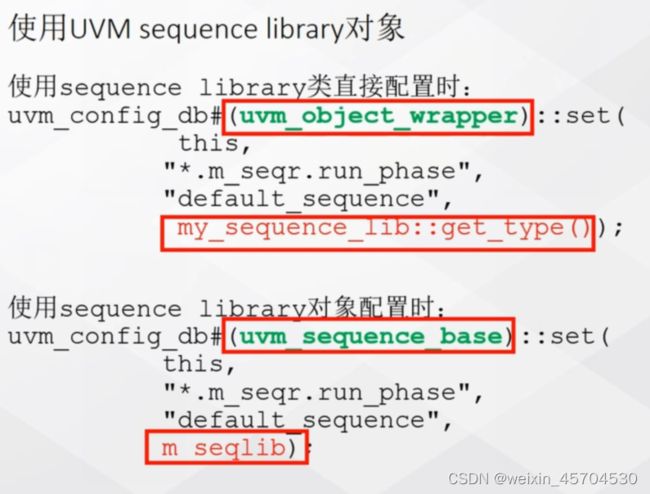UVM——sequence library
sequence library
本质是一个sequence,包含了一组在其内部注册了的sequence类型,可通过对其进行配置,创建并执行一系列的sequence、sequence_item。
向sequence library永久注册sequence
首先创建sequence library类
class my_sequence_lib extends uvm_sequence_library #(my_transaction);
`uvm_object_utils(my_sequence_lib)
// 注册该sequence library
`uvm_sequence_library_utils(my_sequence_lib)
function new(string name = "my_sequence_lib");
super.new(name);
// 初始化该sequence library
init_sequence_library();
endfunction
endclass
接着,创建三个sequence,分别da3_sequence、sa6_sequence、da3_sa6_sequence。
da3_sequence代码如下,其他的方法类似。
class da3_sequence extends my_sequence;
`uvm_object_utils(da3_sequence)
`uvm_add_to_seq_lib(da3_sequence, my_sequence_lib)
int item_num = 10;
function new(string name = "da3_sequence");
super.new(name);
endfunction
function void pre_randomize();
uvm_config_db#(int)::get(m_sequencer, "", "item_num", item_num);
endfunction
virtual task body();
my_transaction tr;
if(starting_phase != null)
starting_phase.raise_objection(this);
repeat(item_num) begin
//`uvm_do(req);
tr = my_transaction::type_id::create("tr");
start_item(tr);
tr.randomize() with { tr.da == 3; };
finish_item(tr);
get_response(rsp);
`uvm_info("SEQ", {"\n", "Sequence get the response:\n", rsp.sprint()}, UVM_MEDIUM)
end
#100;
if(starting_phase != null)
starting_phase.drop_objection(this);
endtask
endclass
临时添加sequence到sequence library
da3_sequence中注释掉`uvm_add_to_seq_lib
class da3_sequence extends my_sequence;
`uvm_object_utils(da3_sequence)
// `uvm_add_to_seq_lib(da3_sequence, my_sequence_lib)
int item_num = 10;
function new(string name = "da3_sequence");
super.new(name);
endfunction
function void pre_randomize();
uvm_config_db#(int)::get(m_sequencer, "", "item_num", item_num);
endfunction
virtual task body();
my_transaction tr;
if(starting_phase != null)
starting_phase.raise_objection(this);
repeat(item_num) begin
//`uvm_do(req);
tr = my_transaction::type_id::create("tr");
start_item(tr);
tr.randomize() with { tr.da == 3; };
finish_item(tr);
get_response(rsp);
`uvm_info("SEQ", {"\n", "Sequence get the response:\n", rsp.sprint()}, UVM_MEDIUM)
end
#100;
if(starting_phase != null)
starting_phase.drop_objection(this);
endtask
endclass
在my_test(test_case)中注册要添加到sequence library中的sequence。
class my_test extends uvm_test;
`uvm_component_utils(my_test)
my_env m_env;
env_config m_env_cfg;
function new(string name = "", uvm_component parent);
super.new(name, parent);
m_env_cfg = new("m_env_cfg");
endfunction
virtual function void build_phase(uvm_phase phase);
super.build_phase(phase);
m_env = my_env::type_id::create("m_env", this);
my_sequence_lib::add_typewide_sequence(da3_sequence::get_type());
my_sequence_lib::add_typewide_sequence(sa6_sequence::get_type());
uvm_config_db#(uvm_object_wrapper)::set(this, "*.m_seqr.run_phase","default_sequence", my_sequence_lib::get_type());
uvm_config_db#(int)::set(this, "*.m_seqr", "item_num", 20);
m_env_cfg.is_coverage = 1;
m_env_cfg.is_check = 1;
m_env_cfg.m_agent_cfg.is_active = UVM_ACTIVE;
m_env_cfg.m_agent_cfg.pad_cycles = 5;
if(!uvm_config_db#(virtual dut_interface)::get(this, "", "top_if", m_env_cfg.m_agent_cfg.m_vif)) begin
`uvm_fatal("CONFIG_ERROR", "test can not get the interface !!!")
end
uvm_config_db#(env_config)::set(this, "m_env", "env_cfg", m_env_cfg);
endfunction
virtual function void start_of_simulation_phase(uvm_phase phase);
super.start_of_simulation_phase(phase);
uvm_top.print_topology(uvm_default_tree_printer);
endfunction
endclass
如下两行代码向my_sequence_lib中注册sequence。
my_sequence_lib::add_typewide_sequence(da3_sequence::get_type());
my_sequence_lib::add_typewide_sequence(sa6_sequence::get_type());
使用sequence library对象来添加sequence
在某一个单独的sequence library实例中添加sequence
class my_test extends uvm_test;
`uvm_component_utils(my_test)
my_env m_env;
env_config m_env_cfg;
my_sequence_lib m_seqlib;
function new(string name = "", uvm_component parent);
super.new(name, parent);
m_env_cfg = new("m_env_cfg");
endfunction
virtual function void build_phase(uvm_phase phase);
super.build_phase(phase);
m_env = my_env::type_id::create("m_env", this);
m_seqlib = my_sequence_lib::type_id::create("m_seqlib", this);
m_seqlib.add_sequence(da3_sequence::get_type());
m_seqlib.add_sequence(sa6_sequence::get_type());
uvm_config_db#(uvm_sequence_base)::set(this, "*.m_seqr.run_phase","default_sequence",m_seqlib);
uvm_config_db#(int)::set(this, "*.m_seqr", "item_num", 20);
m_env_cfg.is_coverage = 1;
m_env_cfg.is_check = 1;
m_env_cfg.m_agent_cfg.is_active = UVM_ACTIVE;
m_env_cfg.m_agent_cfg.pad_cycles = 5;
if(!uvm_config_db#(virtual dut_interface)::get(this, "", "top_if", m_env_cfg.m_agent_cfg.m_vif)) begin
`uvm_fatal("CONFIG_ERROR", "test can not get the interface !!!")
end
uvm_config_db#(env_config)::set(this, "m_env", "env_cfg", m_env_cfg);
endfunction
virtual function void start_of_simulation_phase(uvm_phase phase);
super.start_of_simulation_phase(phase);
uvm_top.print_topology(uvm_default_tree_printer);
endfunction
endclass
实例化my_sequence_lib之后,通过下面的代码注册。
m_seqlib.add_sequence(da3_sequence::get_type());
m_seqlib.add_sequence(sa6_sequence::get_type());
// 配置sequencer中的default_sequence
uvm_config_db#(uvm_sequence_base)::set(this, "*.m_seqr.run_phase","default_sequence",m_seqlib);
sequence library相关变量
****
UVM_SEQ_LIB_RAND: 自定义的seq完全随机
UVM_SEQ_LIB_RANDC: 自定义的seq会先随机排序,然后按照次顺序执行,保证每个seq都执行
UVM_SEQ_LIB_ITEM: sequence library不执行自定义的sequence, 而是自己产生transaction
UVM_SEQ_LIB_USER: 用户自定义算法
selction_mode,min_random_count,max_random_count这三个参数均可通过config机制进行配置。
代码示例
class my_test extends uvm_test;
`uvm_component_utils(my_test)
my_env m_env;
env_config m_env_cfg;
function new(string name = "", uvm_component parent);
super.new(name, parent);
m_env_cfg = new("m_env_cfg");
endfunction
virtual function void build_phase(uvm_phase phase);
super.build_phase(phase);
m_env = my_env::type_id::create("m_env", this);
uvm_config_db#(uvm_object_wrapper)::set(this, "*.m_seqr.run_phase","default_sequence", my_sequence_lib::get_type());
uvm_config_db#(uvm_sequence_lib_mode)::set(this, "*.m_seqr.run_phase", "default_sequence.selection_mode", UVM_SEQ_LIB_ITEM);
uvm_config_db#(int unsigned)::set(this, "*.m_seqr.run_phase", "default_sequence.min_random_count", 20);
uvm_config_db#(int unsigned)::set(this, "*.m_seqr.run_phase", "default_sequence.max_random_count", 40);
// 此处经过实验,配置不了
// uvm_config_db#(int unsigned)::set(this, "*.m_seqr.run_phase", "default_sequence.sequence_count", 38);
uvm_config_db#(int)::set(this, "*.m_seqr", "item_num", 20);
m_env_cfg.is_coverage = 1;
m_env_cfg.is_check = 1;
m_env_cfg.m_agent_cfg.is_active = UVM_ACTIVE;
m_env_cfg.m_agent_cfg.pad_cycles = 5;
if(!uvm_config_db#(virtual dut_interface)::get(this, "", "top_if", m_env_cfg.m_agent_cfg.m_vif)) begin
`uvm_fatal("CONFIG_ERROR", "test can not get the interface !!!")
end
uvm_config_db#(env_config)::set(this, "m_env", "env_cfg", m_env_cfg);
endfunction
virtual function void start_of_simulation_phase(uvm_phase phase);
super.start_of_simulation_phase(phase);
uvm_top.print_topology(uvm_default_tree_printer);
endfunction
endclass
sequence library配置类
上一节配置变量部分代码修改如下:
my_seqlib_cfg = new(
"seqlib_cfg",
UVM_SEQ_LIB_ITEM,
20,
40);
uvm_config_db#(uvm_sequence_library_cfg)::set(
this, "*.m_seqr.run_phase",
"default_sequence.config",
my_seqlib_cfg);

